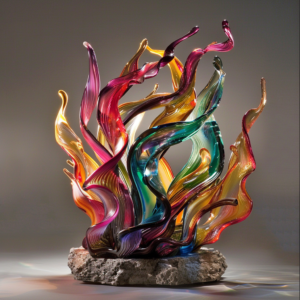Glass sculpting, with its captivating blend of light, form, and color, transcends mere craft. It’s an art form that transforms molten glass into mesmerizing masterpieces. But how do sculptors achieve these breathtaking forms? Let’s delve into the diverse methods used to shape molten glass, exploring the artistry behind each technique.
The Fiery Art of Glassblowing
Glassblowing, a foundational technique, involves blowing air through a hollow pipe (blowpipe) into molten glass to create a bubble. This molten bubble becomes the sculptor’s canvas, manipulated with tools and hand movements into desired shapes. The process demands a delicate balance between heat control, air pressure, and precise movements, creating everything from delicate figurines to large-scale vessels.
The Delicacy of Lampworking
For intricate details and smaller sculptures, lampworking takes center stage. This technique utilizes a focused torch to heat and manipulate small pieces of glass, allowing for precise control and the creation of detailed features. Imagine crafting eyes for a glass sculpture or adding delicate flower petals – lampworking allows for such meticulous artistry.
Fusing: Layering Light and Color
Fusing offers a unique approach to creating multi-layered glass sculptures. Here, sheets of colored glass are meticulously arranged and then heated in a kiln until they bond together. This technique allows for vibrant color combinations, captivating patterns, and the creation of layered effects that play with light refraction. Imagine a stunning glass panel where colors seem to dance and merge, all thanks to the art of fusing.
Kiln Forming: Shaping with Heat and Gravity
Kiln forming utilizes heat and gravity within a kiln to manipulate pre-made sheets of glass. The glass softens but doesn’t fully melt, allowing it to be slumped (draped) over molds or shaped into curved forms. This technique offers flexibility for creating larger pieces with a focus on curved shapes and smooth surfaces. Imagine a captivating glass bowl with a gentle, organic form, brought to life through kiln forming.
The Art of Casting: Replicating in Molten Form
For intricate designs and detailed sculptures, casting becomes the sculptor’s choice. Molten glass is poured into a pre-made mold, allowing it to cool and solidify, replicating the intricate details of the mold. This technique is ideal for creating identical pieces or sculptures with complex details that would be difficult to achieve with other methods. Imagine a glass sculpture with a lifelike animal form, its intricate details captured perfectly through casting.
Beyond Technique: The Artistry of Glass Sculpting
While mastering these techniques is crucial, the true magic of glass sculpting lies in the artistry it empowers. Experienced sculptors possess a keen eye for form, color, and light. They understand the unique properties of molten glass and how to manipulate it to translate their vision into reality. The process itself becomes a captivating dance – the rhythmic puffs of air, the deft movements of the tools, and the ever-changing form of the molten glass all contributing to the artistic expression.
Conclusion: A World of Creative Possibilities
Glass sculpting techniques offer a diverse toolbox for shaping molten magic into captivating works of art. From the fiery dance of glassblowing to the meticulous detail of lampworking, each technique unlocks a world of creative possibilities. Whether an artist seeks to create delicate figurines, vibrant fused panels, or large-scale installations, the world of glass sculpting offers a medium ripe for exploration and artistic expression. So, delve into this captivating art form, explore the diverse techniques, and unleash your inner artist to create your own masterpieces in molten glass.



